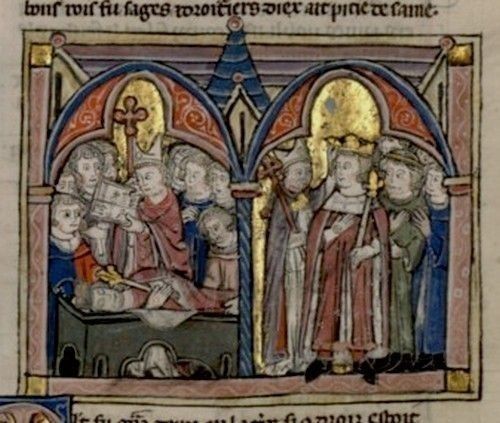Ancient Psychedelia: Alien Gods & Mushroom Goddesses
Online Book - Chapter 17, Page 320
Back to Online Book Mainpage / Next Page (Chapter 17, Page 321)
| Baldwin II was a younger son of Hugh I, Count of Rethel and Melisende of Monthléry and cousins of Godfrey of Bouillon, and Baldwin of Boulogne. (22) So, Baldwin II’s mother was named Melisende and his daughter was named Melisende as well. Baldwin II was the lord of Bourcq when he joined the army of Godfrey of Boulogne at the beginning of the First Crusade. (23) He was King of Jerusalem from 1118 to 1131. Baldwin II had a daughter, Melisende, who then gave birth to King Baldwin III of Jerusalem (1130 – 10 February 1163). She was the Queen of Jerusalem and regent for her son, from 1131 to 1153 and she was the eldest daughter of King Baldwin II of Jerusalem, and the Armenian princess Morphia of Melitene. Baldwin III was King of Jerusalem from 1143 to 1163. Melisende and Fulk V had a second son, Amalric I, who was King of Jerusalem from 1163 on. Amalric I had a son, Baldwin IV with his first wife Agnes of Courtenay. In a painting from 1173-1200 AD, his coronation is depicted under a pair of arches which look suspiciously like mushroom caps while Baldwin IV himself appears to take the place of the stem of the mushroom (67h).  (67h) Coronation of King Baldwin IV c. 1174-1200 AD Baldwin IV (French: Baudouin, 1161 – 16 March 1185), was called the Leper, or The Leper King, and reigned as King of Jerusalem from 1174-1185. In the summer of 1180, Baldwin IV married his sister Sibylla to Guy de Lusignan, brother of Aimery II (1148-1205). Amalric II descends from Hugh VIII of Lusignan and Dame de Fontenay. This now introduces the Lusignan family into the tree which already includes the House of Lorraine. Amalric II married Eschiva, the daughter of Baldwin of Ibelin, and became family of English-related royalty. Baldwin's first cousin was Henry II of England. He had previously been expelled by Richard Lionheart from England where his family owned land. Aimery’s brother Guy de Lusignan, arrived in Jerusalem at some date before Easter 1180. Guy was a vassal of Richard of Poitou and Henry II, and had been formerly rebellious, so they wanted to keep him overseas. |
Around 1192, Richard the Lionheart sold Cyprus to the Knights Templars, who in turn sold it to Guy. Guy later died in 1194, leaving it to his older brother Aimery, aka Amalric II de Lusignan. Henry VI, Holy Roman Emperor crowned Aimery of Lusignan as the first king of Cyprus. In 1197 Aimery married Isabella I, which brought the crown of Jerusalem back to the Lusignans. (24) This might seem like a small connection at first, but the fact that the Holy Roman Emperor crowned Aimery King of Cyprus who later married Isabella I, Queen of Jerusalem makes it apparent that the Catholic Church is married as well to the King and Queen of Jerusalem. Paul Sire writes, in King Arthur’s European Realm: “The Lusignans accumulated an impressive array of titles that extended their influence almost as far and wide as the Roman emperors had done.” (25) By the year 1200, an English French Royal Alliance had been formed and continued on until the modern age. Both of these royal houses are aligned with the Title King of Jerusalem. This was originally a “Joint-venture” with the Catholic Church as well. All of the surviving, remaining royal houses allowed to flourish under the Catholic Church were secretly “mushroom houses.” All of them carried the knowledge of the use of entheogens, however, they were all required to keep it a dire secret. This appears to be the one condition and rule. We see that certain houses under the Capets were allowed to flourish like the Lusignans, while orders set up as military arms of the church like the Templars or families in areas of Languedoc-Roussillon and Midi-Pyrénées, involved with the Cathars and Albigensians were wiped out. The church appeared in the 13th century as a consolidating power in the east and west parts of Europe as it attempted to retake power in the Middle East where the goal was to establish the Kingdom of Jerusalem. They have almost finished doing it today, with the State of Israel. In a short summary, from Wiki: “the city of Jerusalem was lost in 1187, but the Kingdom of Jerusalem survived, moving its capital to Acre in 1191. The city of Jerusalem was re-captured in the Sixth Crusade, during 1229–39 and 1241–44. The Kingdom of Jerusalem was finally dissolved with the fall of Acre and the end of the Crusades in the Holy Land in 1291. After the Crusader States ceased to exist, the title of King of Jerusalem was claimed by a number of European noble houses descended from the kings of Cyprus or the kings of Naples. The (purely ceremonial) title of King of Jerusalem is currently used by Felipe VI of Spain. It was claimed by Otto von Habsburg as Habsburg pretender, and by the kings of Italy until 1946.” (26) (22) Murray, Alan V. (1992). "Dynastic continuity or dynastic change? Accession of Baldwin II and the nobility of the Kingdom of Jerusalem". Medieval Prosopography. 13: 1–27 (23) Runciman, Steven (1989a). A History of the Crusades, Volume I: The First Crusade and the Foundations of the Kingdom of Jerusalem. Cambridge University Press (24) https://en.wikipedia.org/wiki/House_of_Lusignan (25) Paul Sire, King Arthur's European Realm: New Evidence from Monmouth's Primary Sources, 2014 (26) https://en.wikipedia.org/wiki/King_of_Jerusalem |
Go Back to Page 319